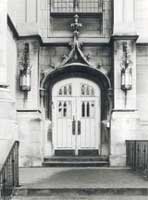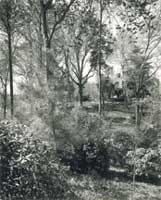Getting Warm
A Roundup Of Warm-Tone Black And White Papers
Here I go again dating myself,
but I remember going through packs of Kodak Athena, a double-weight
contact paper with a lovely brown-black image. Actually, the tone varied
daily from warm to neutral depending upon the condition of my fledgling
technique and oxidized chemistry, but the manufacturer said it was a
"warm-tone paper, suitable for portraits." I also liked
the stuff for two very pragmatic reasons--it was cheap, and so slow
that it wouldn't fog too badly in my not-so-dark closet darkroom. |
|||
To edify those just starting
out in the darkroom, as well as to nudge those who may have dozed off
in it, this month we present a roundup of current warm-tone paper offerings.
Every emulsion has a tone to its image, that is how blue or brown the
black areas will be after normal processing. Cold-tone papers are often
used for commercial and industrial photography, neutral-tone papers for,
well, just about anything, with warm-tone generally reserved for portraits
and landscape. Of course, one photographer's cold-tone is another's
neutral, and a high-profile ad might be printed on the warmest paper available
for effect, so be sure to try many and find the one best suited for your
images. |
|||
Range is a logarithmic indication
of how "broad" the image will be on the paper in shades of
gray at a given grade, with a high number indicating a wide range with
gentle transition. Papers come in a choice of surfaces from high gloss
to deep matte in many different sizes, and although only off-the-shelf
sheet sizes are listed, many manufacturers offer special sheet sizes,
rolls (for machine printing), and even custom sizes by special order.
Unless otherwise indicated, all papers can be developed in standard regular
or warm-tone paper developers, the latter giving the most pronounced effect
with many, and can be handled under an amber (Kodak OC or equivalent)
or red (Kodak No. 1) safelight. |
|||
Photo 1. Agfa--Portriga-Rapid.
Type: fiber-based enlarging; base: double weight, baryta coated without
white toner; contrast: graded; 2 (normal) and 3 (hard); speed: grades
2 and 3, P250; range: grade 2, R120; grade 3, R90; surface: glossy; sizes:
5x7" to 20x24". |
|||
Photo 2. Bergger--Prestige
CB And CM. Type: fiber-based enlarging; base: double weight (CB), premium
weight (CM), baryta coating; contrast: graded; 2, 3, and 4; surface: glossy;
sizes: 8x10" to 20x24". |
|||
Photo 4. Centennial--Printing-Out
Paper. This charming, English-made contact printing paper is the last
surviving "POP," a century-old design in which the image appears
without chemical development as exposure progresses. The normal image
tone is reddish-brown, but it can be widely varied by post-exposure toning.
The gelatin chloride emulsion has a fine-luster glossy surface and is
coated on a double-weight fiber base. This UV-sensitive paper is exceptionally
slow, requiring exposures of a minute or more in direct sunlight, but
can be safely handled under moderate incandescent room light. Fixing and
washing is required to make the image permanent. |
|||
Photo 6. Ilford--Multigrade
FB Warmtone. Type: fiber-based enlarging; base: double weight, baryta
coated, warm white; contrast: filtered, variable grades 00-5; speed: grades
00-3, P100; grades 4 and 5, P50; range: grade 0, R160; grade 2, R110;
grade 5, R50; surfaces: glossy, semimatte; sizes: 5x7" to 20x24". |
|||
Photo 7. Ektamatic
SC. Type: fiber-based enlarging; base: single weight, white with optical
brightener; contrast: filtered, variable grades 0-5; speed: grades 0-3,
P200; grade 31/2, P160; grades 4 to 5, P100; range: grade 0, R160; grade
2, R120; grade 5, R80; surfaces: glossy, semimatte; sizes: 4x5"
to 16x20"; developer: Kodak SII Activator, Ektamatic S30 Stabilizer. |
|||
Photo 8. Luminos--Classic
Series. Type: fiber-based enlarging; base: see below; contrast: graded;
21/2 only; speed: P160; surfaces: see below; sizes: most standard sheet
sizes. |
|||
Photo 10.
Premium F. Type: fiber-based enlarging; base: double weight; contrast:
graded; 1, 2, 3, 4, and 5; speed: grades 1-3, P350; grade 4, P250; grade
5, P100; range: grade 1, R130; 2, R105; 3, R85; 4, R65; 5, R50; surfaces:
glossy, silk, luster; sizes: 8x10" to 20x24". Manufacturers/Distributors Agfa Photo Division Cachet/Fappco Chicago Albumen Works (Centennial) Eastman Kodak Company Ilford Photo International Supplies (Oriental) Lotus View Camera/North America
(Bergger) Luminos Satter/Omega, Inc. (Forte) Sterling Papers |
- Log in or register to post comments











































